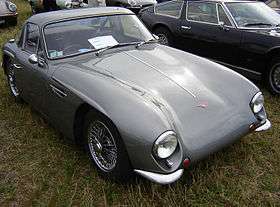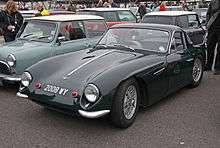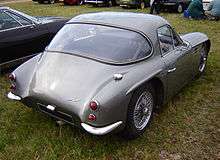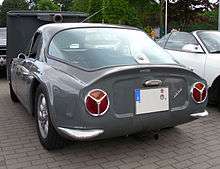TVR Grantura
The TVR Grantura is the first model in a long line of TVR cars and debuted in 1958. The cars went through a series of developments leading to the I to IV and 1800S models. The last ones were made in 1967.
| TVR Grantura | |
|---|---|
.jpg) 1961 TVR Grantura Mark IIA | |
| Overview | |
| Manufacturer | TVR |
| Production | 1958–1967 |
| Assembly | Blackpool, England |
| Body and chassis | |
| Class | Sports car |
| Layout | FR layout |
| Chronology | |
| Successor | TVR Vixen |
These coupés were hand-built at the TVR factory in Blackpool, England with varying mechanical specifications and could be had in kit form. All cars featured a cocktail of Austin-Healey brakes, VW Beetle or Triumph suspension parts and BMC rear axles.
The Grantura bodyshell was made from glass-reinforced plastic and made use of a variety of proprietary components. The bonnet was front hinged. There was no opening at the rear but the boot could be accessed from inside the car - the spare wheel had to be removed through the front doors. Buyers could choose from a range of powerplants which included a choice of side or overhead valve engines from Ford, a Coventry Climax unit or the MGA B-series engine.
Series I
| TVR Grantura Series I | |
|---|---|
| Overview | |
| Production | 1958–1960 |
| Layout | FR layout |
| Powertrain | |
| Engine | 1,098 cc straight-4 1,172 cc straight-4 |
| Dimensions | |
| Wheelbase | 83.5 in (2,121 mm) [1] |
| Length | 136.5 in (3,467 mm) [1] |
| Width | 65.5 in (1,664 mm) [1] |
| Height | 47 in (1,194 mm) [1] |
The first of the Granturas used a fibreglass body moulded to a tubular steel backbone chassis and VW Beetle-based front and rear suspension. The car was designed around a 1,098 cc Coventry Climax type FWA engine but many different makes were fitted from 1,172 cc Ford side valve to 1600 cc BMC from the MGA. The drum brakes originated on the Austin-Healey 100 and the windscreen on the Ford Consul.[2]
Approximately 100 of the series I Grantura were built from 1958 to 1960.[3]
Series II
| TVR Grantura Series II | |
|---|---|
 | |
| Overview | |
| Production | 1960–1962 |
| Layout | FR layout |
| Powertrain | |
| Engine |
|

The Series II had MGA engines as standard but again customers could choose from a variety of power units. The IIA used the 1622 cc MGA Mark II or Ford 1340 cc engine and front disc brakes were standard. Rack and pinion steering was standardised.
A car with a 1600 cc MGA engine was tested by the British magazine The Motor in 1961. It had a top speed of 98.4 mph (158.4 km/h) and could accelerate from zero to 60 mph (97 km/h) in twelve seconds. Fuel consumption of 32.8 miles per imperial gallon (8.6 L/100 km; 27.3 mpg‑US) was recorded. The test car cost £1,298 including taxes.[1]

Approximately 400 of the series II Grantura were built.[3]
Series III, Series III 1800, 1800S and IV
| TVR Grantura Series III, Series III 1800, 1800S, and MkIV | |
|---|---|
.jpg) 1962 Grantura Mark III | |
| Overview | |
| Production | 1962–1967 |
| Layout | FR layout |
| Powertrain | |
| Engine |
|
| Dimensions | |
| Wheelbase | 85.5 in (2,172 mm)[4] |
| Length | 138 in (3,505 mm)[4] (SIII, SIII 1800, 1800S) 141.5 in (3,594 mm)[4] (MkIV) |
| Width | 64 in (1,626 mm)[4] (SIII, SIII 1800, 1800S) 65.5 in (1,664 mm)[4] (MkIV) |
The final series of cars had a new, longer and stiffer chassis and coil sprung independent suspension. This chassis was designed by John Thurner and would form the basis of the one used by TVR up to the launch of the 2500M cars in 1972. The Series III received a new front design, with the grille mounted higher and featuring some rudimentary chrome trim.
The Series III and Series III 1800 used MG engines, either 1622 or 1798 cc respectively, although Ford or Coventry Climax units were also available for the earlier Series III model.[5]
In 1964 the car became available as the 1800S with a cut off, square back (called a 'Manx tail' after the similarly tailless breed of cat) and round rear light clusters from the Ford Cortina. The chassis used for the 1800S and all subsequent Granturas was a very slightly modified version that allowed more space for the engine to fit in. This was an alteration made to the Grantura chassis to allow it also to be used as the basis for the new Griffith, a car that sported a V8 engine which was larger both in capacity and physical dimension.
After a stop in production in 1965, under Martin Lilley's new ownership the 1800S reappeared in 1966 as the longer MkIV.[3] The MkIV also featured better trim and a larger fuel tank.[5]
Approximately 300 cars were built (estimated to be 60 of the Series III, 30 of the Series III 1800, 128 of the 1800S and 78 of the MkIV) before being replaced by the Vixen.[3]

TVR Grantura in pre-1966 Historic Racing
The Series III 1800, introduced in September 1963, is the rarest variant but by far the most popular model for pre-1966 historic racing as it was homologated with wider wheels than the original Series III as well as slightly larger carburettors and the option to use a limited slip differential. The Series II and the initial version of the Series III had their own distinct sets of homologation papers and, for racing purposes, many of the cars that were originally built as these models have been since modified to run to the later Series III 1800 specification.
The TVR Grantura is eligible for a wide range of historic racing and the smaller engined Series III cars (MG engined, 1622cc) built to 1962 specification are eligible to run in the prestigious bi-annual Classic Le Mans race for cars that competed in period at Le Mans.
References
- "The T.V.R. Grantura". The Motor. 29 March 1961.
- Sedgwick, M.; Gillies.M (1986). A-Z of Cars 1945-1970. Devon, UK: Bay View Books. ISBN 1-870979-39-7.
- Robson, Graham (2006). A–Z British Cars 1945–1980. Devon, UK: Herridge & Sons. ISBN 0-9541063-9-3.
- James M. Flammang (1994). Standard Catalog of Imported Cars, 1946-1990. Iola, WI: Krause Publications, Inc. pp. 616–617. ISBN 0-87341-158-7.
- Lawrence, Mike (1991). A to Z of Sports Cars. Bideford, Devon: Bay View Books. pp. 309–310. ISBN 1-870979-81-8.